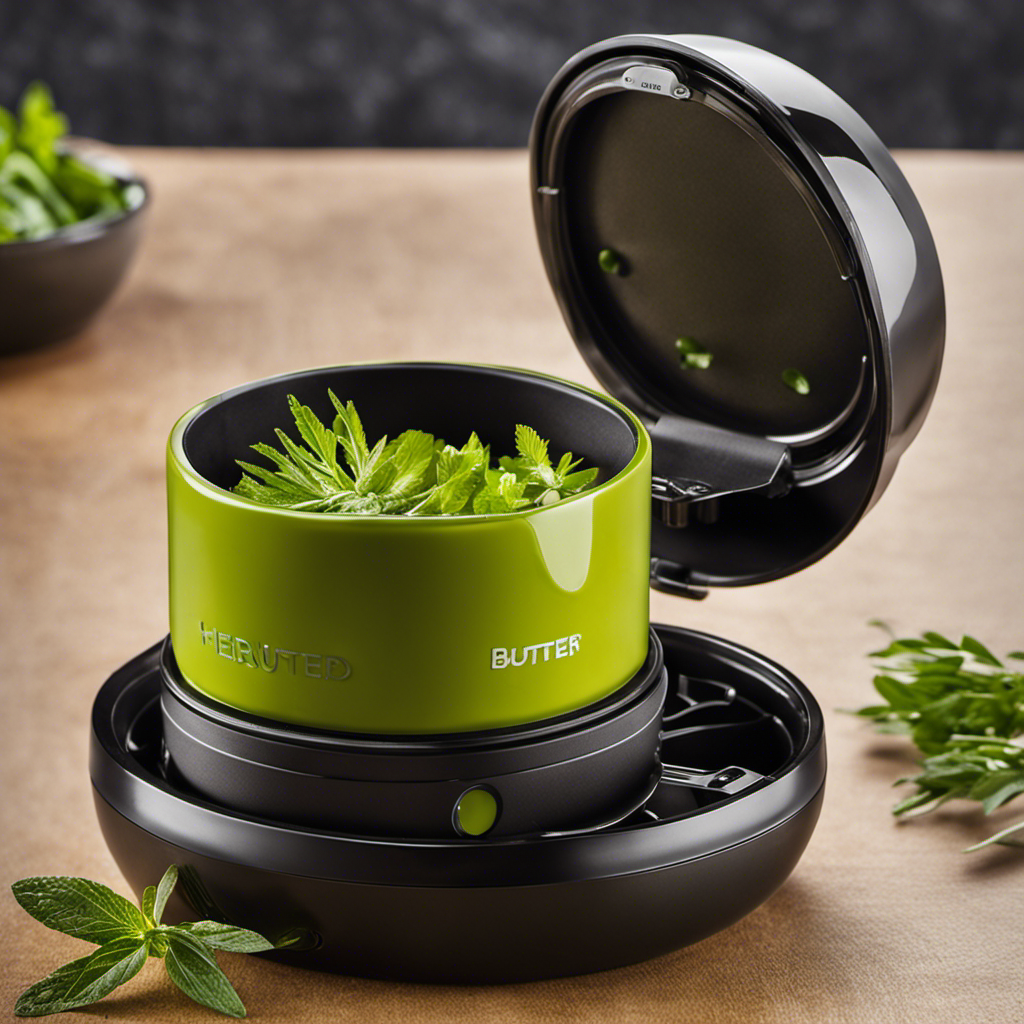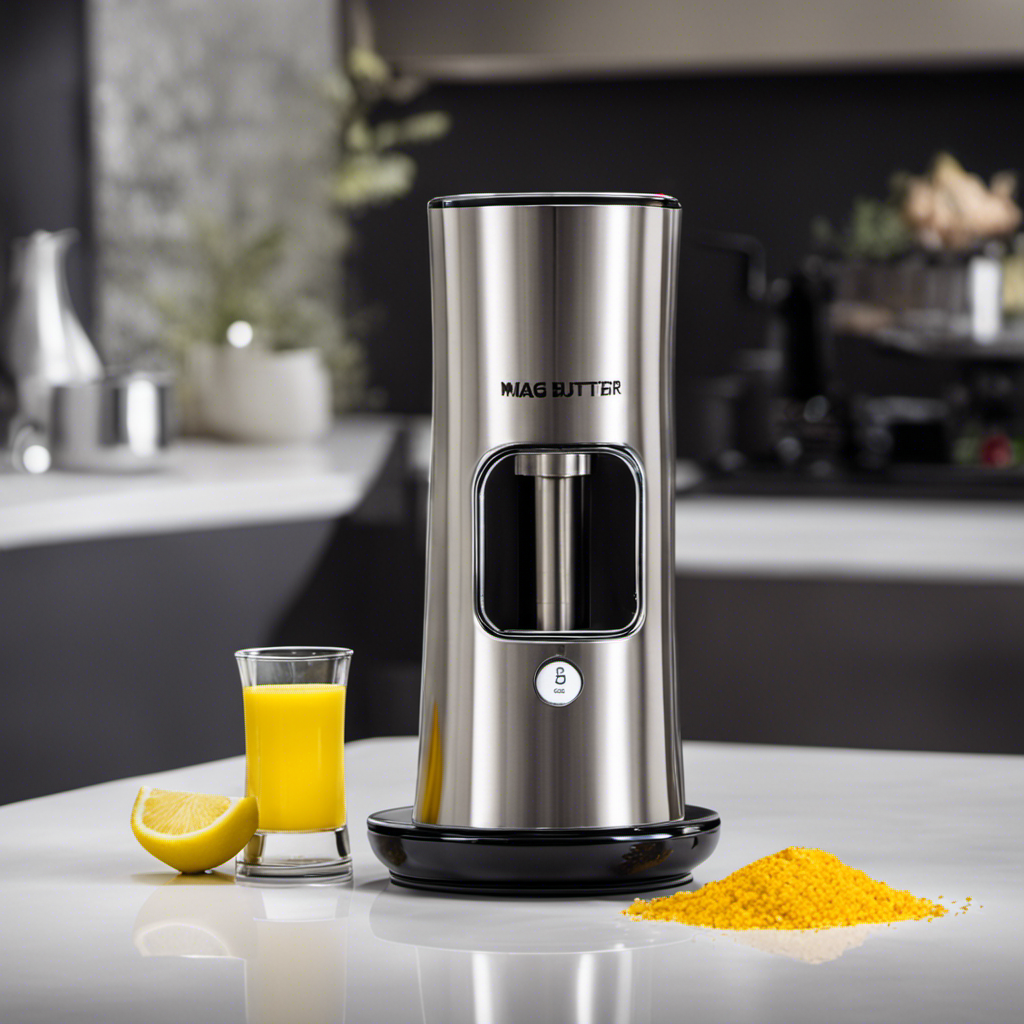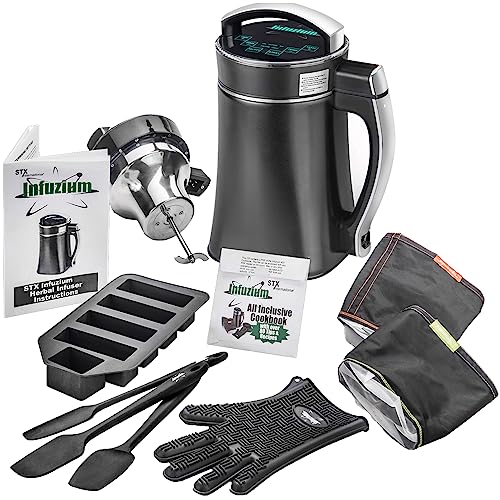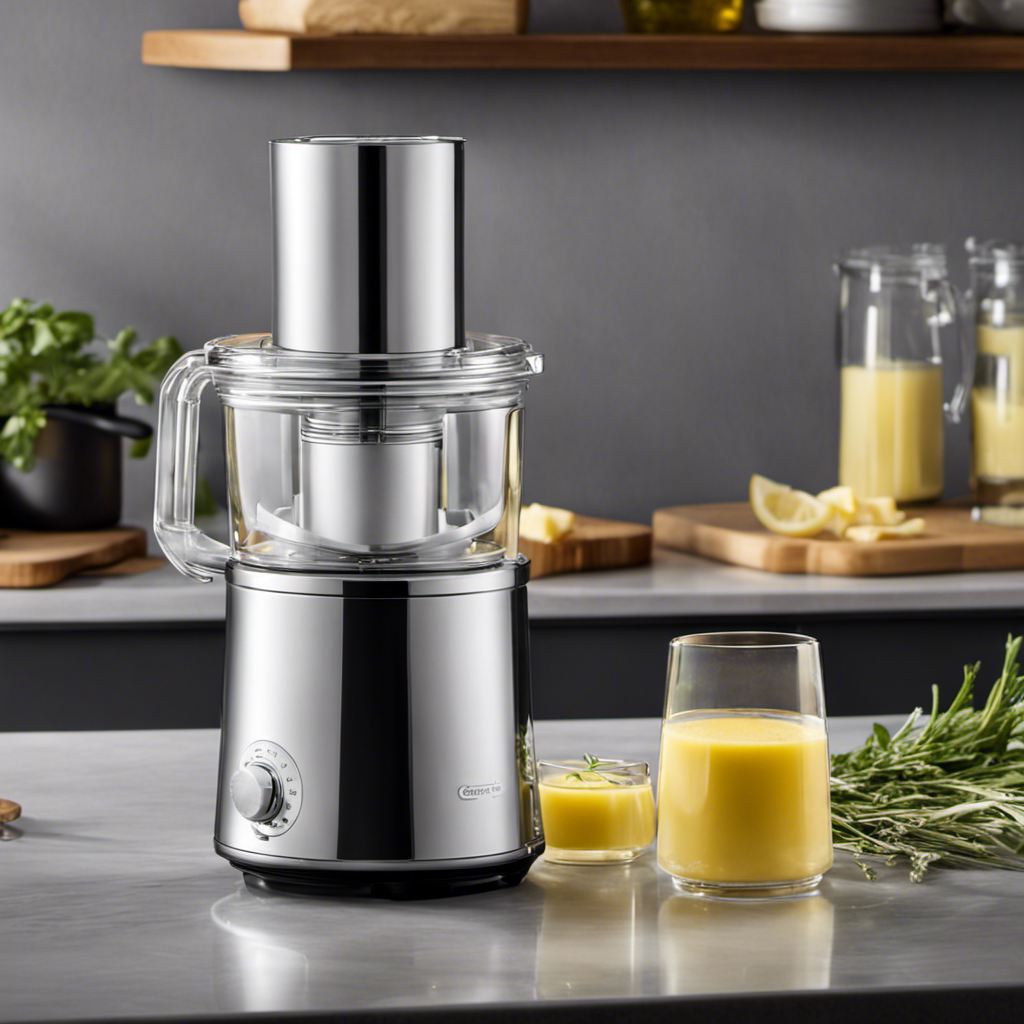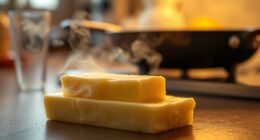Manual churns give you more control, producing rich textures and unique flavors, but they take longer and require physical effort. Electric churns are faster, more efficient, and produce consistent butter at higher capacities, though they cost more upfront. Your choice depends on your scale, tradition, and convenience preferences. Want to discover how each method impacts yield, quality, and long-term use? Keep exploring to find the best fit for your needs.
Key Takeaways
- Manual churns produce nuanced, artisanal butter with variable yields influenced by technique and effort, ideal for small-scale or traditional production.
- Electric churns offer consistent, uniform yields quickly, suitable for large-scale or commercial butter production.
- Manual methods require significant physical effort and longer time, while electric models significantly reduce processing time and labor.
- Capacity differs: manual churns handle 1-5 gallons, whereas electric churns process 10-50 gallons, affecting overall yield volume.
- Both churn types can produce high-quality butter when properly managed, but yield consistency and efficiency vary between methods.
Measuring Butter Yield: Manual vs. Electric Churns

When it comes to measuring butter yield, choosing between manual and electric churns can substantially impact your efficiency and accuracy. Manual churns often allow for greater control, helping you achieve consistent flavor and texture, which can preserve flavor consistency across batches. Historically, manual churns hold significant value because they reflect traditional methods used for generations, adding a sense of craftsmanship and authenticity to your process. Electric churns, on the other hand, can streamline the measurement process, reducing human error and providing more precise yield readings. Both types influence the way you monitor and refine your butter-making, but your choice can shape the consistency and historical significance of your product. Ultimately, understanding these differences helps you produce butter that meets your quality standards.
Time Investment and Efficiency Differences

Manual churns require you to spend a lot of time and effort, which can slow down your process. In contrast, electric churns produce butter much faster, saving you valuable time. Understanding these differences helps you choose the right tool for your needs.
Manual Churn: Time-Consuming Effort
Churning butter by hand requires a significant time investment, making it a labor-intensive process that can take anywhere from 30 minutes to several hours depending on the quantity. With traditional methods, you must dedicate substantial manual effort, continuously moving the paddles or dasher to agitate the cream. This process demands patience and physical stamina, especially when working with larger batches. Unlike modern electric churns, manual effort doesn’t speed up the task; instead, it prolongs the time needed to produce butter. The repetitive motion can be tiring, and the overall efficiency is low. If you’re seeking quick results, manual churning isn’t ideal. Instead, it emphasizes craftsmanship and tradition, but at the cost of significant time and energy.
Electric Churn: Rapid Production
Have you ever wondered how electric churns dramatically cut down the time needed to make butter? With an electric churn, you can produce butter in a fraction of the time manual methods require. This efficiency means you spend less effort and more time enjoying your finished product. Plus, the rapid process helps preserve the natural flavor, maintaining the butter’s freshness and richness. The convenience of electric churns also highlights their historical significance in modern dairy production, blending tradition with innovation. You get to experience the satisfying process without sacrificing quality or flavor. Additionally, the use of performance-enhancing upgrades in modern churn designs can further improve their speed and consistency.
Physical Effort Required for Each Method

When choosing a butter churn, consider how much physical effort you’ll need. Manual churners require you to use your strength to turn the handle, which can be tiring over time. In contrast, electric models make the process much easier by automating the movement. Additionally, high refresh rates in projectors can enhance your viewing experience, just as choosing a motorized churn can simplify the butter-making process.
Manual Churner Strength
Manual churners require varying levels of physical effort depending on their design and the technique used. You’ll find that some models demand more manual strength, making the process tiring over time. As you turn the handle or pump, you might feel your muscles working harder, especially if the churn is heavy or resistance is high. The physical effort involved can be a test of endurance, leaving you exhausted after just a few minutes.
- Feel your muscles strain with each turn, testing your stamina.
- Experience the satisfaction of manual strength powering the process.
- Embrace the challenge, knowing your effort directly influences the yield.
Electric Motor Ease
Ever wondered how effortless butter churning can be with an electric motor? With electric motor ease, you barely need to apply any physical effort. Simply turn on the machine, and the user interface guides you through straightforward settings. Unlike manual churners, which demand consistent strength and stamina, electric models handle the process smoothly and quietly. The user interface often features simple buttons or touchscreens, making operation intuitive even for beginners. You don’t need to worry about maintaining rhythm or applying force; the motor does all the work. This convenience allows you to focus on other tasks or relax while your butter churns effortlessly. Overall, electric motors drastically reduce physical effort and simplify the entire process, making butter churning more accessible and less labor-intensive. AI-driven innovations in appliance technology continue to enhance user convenience and efficiency.
Consistency and Quality of Butter Produced
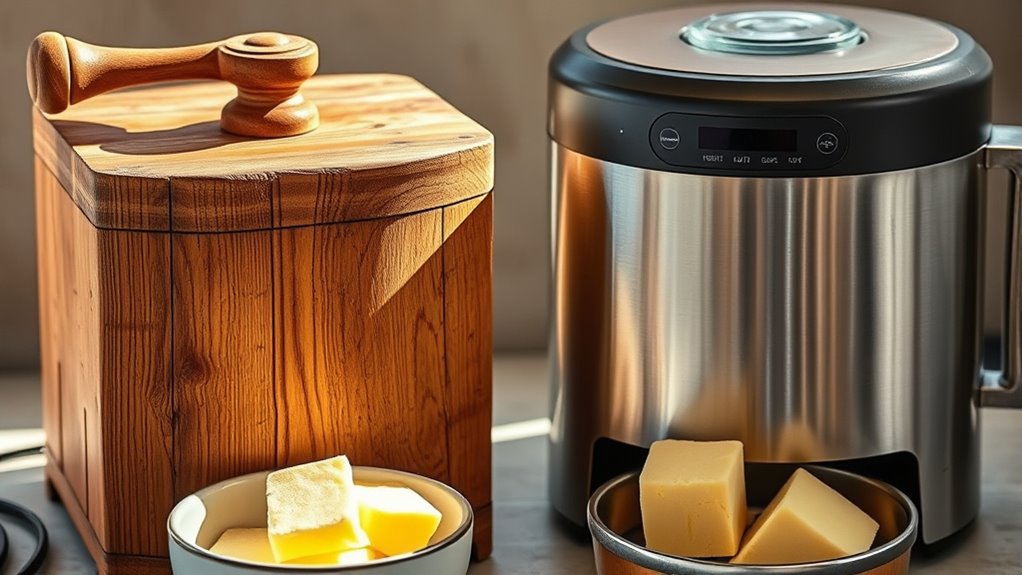
The consistency and quality of butter produced depend heavily on the churning process, as well as the ingredients and techniques used. Your butter’s texture and flavor consistency will vary based on these factors. Manual churning often yields a more nuanced butter, with a richer, creamier texture and a unique flavor profile that reflects your effort. Electric churns, on the other hand, can produce a more uniform butter quickly, but sometimes at the expense of subtle differences in texture and taste. When you focus on technique, you can create butter that’s irresistibly smooth and flavorful, whether manual or electric. Mechanical precision can also influence the final product, especially in electric churning, where consistent motor performance impacts texture. – Feel the pride in crafting butter with a perfect, velvety texture – Savor the confidence of consistent flavor in every batch – Experience the joy of producing high-quality butter you can truly trust
Capacity and Batch Size Comparison

When choosing between different churning methods, considering capacity and batch size is essential to meet your production needs. Manual churns typically handle smaller batches, making them suitable for ingredient variations and traditional processes with historical significance. Electric churns, on the other hand, process larger quantities efficiently, ideal for scaling up. Here’s a quick comparison:
| Churn Type | Typical Batch Size | Suitable for |
|---|---|---|
| Manual | 1-5 gallons | Small-scale, traditional |
| Electric | 10-50 gallons | Large-scale, commercial |
| Hybrid | 5-20 gallons | Medium-scale, versatile |
Understanding these differences helps you select the right churn for your needs, balancing tradition with efficiency. End-of-Life Care considerations can also influence the planning and support needed during the process.
Energy Consumption and Environmental Impact

Choosing the right butter churn also involves considering energy consumption and environmental impact. Electric churns typically use more electricity, increasing your carbon footprint, especially if powered by non-renewable resources. Manual churns, on the other hand, require no electricity, making them eco-friendly options that preserve our planet’s resources. Additionally, manual churns can be a cultural tradition, connecting you to historical methods of dairy processing.
Consider these emotional impacts:
- Feel pride in reducing your reliance on fossil fuels.
- Enjoy the satisfaction of a low-carbon footprint.
- Contribute to preserving renewable resources for future generations.
Ease of Use and User-Friendly Features

Selecting a butter churn that is easy to operate can make the entire process more enjoyable and less frustrating. An ergonomic design ensures that handling the churn feels comfortable, reducing fatigue during extended use. Look for models with intuitive user interfaces that simplify the churning process, even for beginners. Electric churns often feature straightforward controls, such as buttons or touchscreens, making operation effortless. Manual churns with ergonomic handles provide better grip and reduce strain. Clear instructions and simple adjustments also contribute to user-friendliness. When choosing a churn, consider how easily you can assemble, operate, and clean it. A well-designed, user-friendly churn minimizes confusion and effort, so you can focus on making delicious butter without unnecessary hassle. Incorporating sound ergonomic principles in the design can further enhance ease of use and comfort.
Cost Analysis of Manual and Electric Churns

Manual and electric butter churns vary considerably in cost, impacting your overall budget and decision-making process. Manual churns often reflect historical techniques with cultural significance, making them more affordable but labor-intensive. Electric churns, while pricier upfront, offer convenience and faster yields, which may justify the investment for modern needs. Additionally, choosing between them can influence the soundscape associated with your butter-making process, especially if authentic, handcrafted sounds are part of your experience. Consider these emotional factors:
- Preserving cultural heritage through traditional methods
- Supporting artisanal craftsmanship
- Achieving authentic, handcrafted butter
Your choice depends on whether you value historical techniques and cultural significance or prioritize efficiency and modern convenience. Manual churns tend to be less expensive initially, but electric models can save time and labor costs over the long run. Ultimately, your budget influences how you weigh tradition against practicality.
Maintenance and Durability Considerations
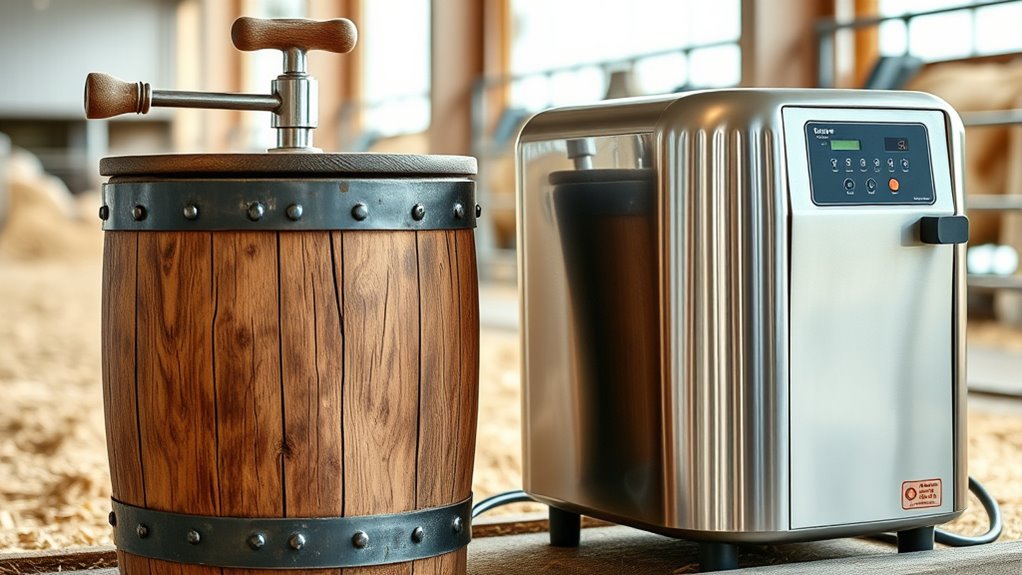
Maintenance and durability are critical factors to contemplate because they directly affect the long-term performance and cost-effectiveness of your butter churn. Regular cleaning procedures prevent buildup and corrosion, extending the device’s lifespan. Proper storage requirements protect your churn from damage, rust, and dust, ensuring it stays in ideal condition. Manual churning often requires more frequent upkeep due to exposed mechanical parts, while electric models may need less maintenance but can be more sensitive to storage conditions. Consider how easy it is to clean and store your churn when making a decision. Additionally, understanding narcissistic traits can help identify potential issues with personal or emotional investment in the maintenance process.
Suitability for Small-Scale vs. Large-Scale Production

When considering whether a butter churn is suitable for your needs, it’s important to evaluate its capacity and efficiency in relation to your production scale. Historically, developments in butter churning reflect cultural significance, shaping communities for generations. For small-scale use, manual churning offers intimacy and tradition, preserving heritage. It’s perfect if you value handcrafted quality and local history. Large-scale production, however, demands electric churns that maximize yield and speed, supporting commercial needs. Choose based on your goals:
- Connect with history and culture through small, artisanal methods
- Achieve higher output efficiency for commercial ventures
- Ensure your equipment aligns with your production volume and purpose
Frequently Asked Questions
Which Type of Churn Is More Suitable for Beginner Butter Makers?
If you’re a beginner butter maker, you want a churn that’s beginner friendly and easy to use. An electric churn is more suitable because it offers greater ease of use, saving you time and effort. It simplifies the process, allowing you to focus on learning and enjoying butter making. Manual churns can be more challenging initially, but electric ones provide a smoother, more accessible experience for those just starting out.
How Do Manual and Electric Churns Differ in Noise Levels During Operation?
You might find the noise comparison between manual and electric churns quite charming. During operation, electric churns tend to produce a steady, gentle hum, making the operation sound more consistent and less intrusive. Manual churns, on the other hand, create a rhythmic, sometimes louder clicking or clattering sound, which some find more engaging. Overall, electric churns offer a quieter experience, ideal for those seeking a peaceful, low-noise environment.
Are There Safety Concerns Associated With Electric Churns?
When using electric churns, you should be aware of safety concerns like potential electric shocks if the device isn’t properly grounded or maintained. There’s also a fire hazard if electrical components overheat or if there’s a short circuit. Always follow manufacturer instructions, keep the appliance dry, and inspect cords regularly. Taking these precautions helps prevent accidents, ensuring safe operation during your butter-making process.
Can Manual Churns Be Used for Other Dairy Products?
Imagine discovering that your manual churn can do more than just make butter. Yes, you can use manual churns for alternative dairy products like homemade cheese, yogurt, or cream. Their versatile design allows for non-butter uses, giving you a hands-on approach to creating various dairy treats. So, next time you’re churning, think beyond butter—your manual device can be a valuable tool for many dairy adventures.
What Are the Long-Term Cost Savings of Electric Over Manual Churns?
You’ll find that electric churns offer significant long-term cost savings compared to manual ones. Their cost efficiency comes from faster processing times and higher yields, reducing labor costs over time. Plus, maintenance costs are usually lower because electric models have fewer moving parts and are built for durability. While the initial investment may be higher, in the long run, electric churns save you money through improved productivity and lower ongoing expenses.
Conclusion
Choosing between manual and electric churns depends on your needs. If you’re aiming for efficiency, electric churns can increase butter yield by up to 30% compared to manual methods. They also save time and reduce physical effort. Whether you run a small farm or a large dairy operation, understanding these differences helps you pick the right equipment. Ultimately, the right choice boosts productivity and quality, making your butter-making process smoother and more enjoyable.



